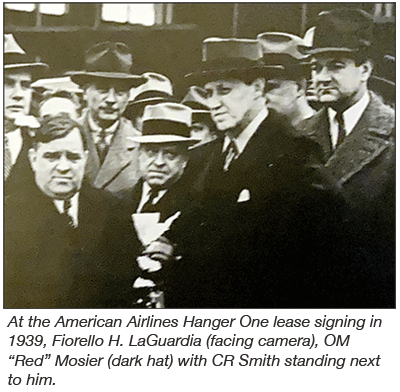Just came across an announcement that
American Airlines Hangar 3 and 5, the old ones from 1939 have been
cleaned up at LaGuardia Airport.
That
only caught my eye as the notice casually mentioned that Hangar 1
that sat astride Hangar 3 and 5, and was the original AA domestic
passenger facility and one of the most historically significant buildings
on any airport anywhere was demolished last October.
Hangars
3 and 5 look nice with new windows and the brick cleaned, maybe for
the first time in decades, in the style of the late 1930s and for
sure have a lot of history. But to compare them in value historically
with Hangar 1 is like trying to match up some pseudo paste with the
Hope Diamond.
But now Hangar 1 is
gone with the wind, just like a leaf that has blown away.
Wonder
where all the steel and other demolition debris from Hangar 1 ended
up?
In its past LaGuardia expanded
itself on top of landfill and junk. Before Rikers Island was a city
prison, it was a city dump. Across the bridge to LaGuardia Airport
abuilding in 1937 came garbage that created much of the original airport
except the ground on which The Marine Air Terminal still sits today.
“Actually” an old time
hauler told me, “the original airport made more money for the
people that fixed the balloon tires on those 1930s trucks.
“Tires
were always springing leaks as the land fill included bed springs
and lots of glass,” he said.
At
one point, legend has it that LaGuardia Airport welcomed arrival of
some parts of the demolished Penn Station in Manhattan as landfill
under its terminals.
 That
there would be a LaGuardia, with airplanes in New York City when the
airport at North Beach readied in 1939, was guaranteed by Hangar One. That
there would be a LaGuardia, with airplanes in New York City when the
airport at North Beach readied in 1939, was guaranteed by Hangar One.
That happened when Mayor Fiorello H.
LaGuardia convincing American Airlines founder CR Smith and OM “Red”
Mosier, (the brilliant negotiator CR had just coaxed away from Braniff)
to move AA's corporate headquarters people, airplanes, maintenance,
reservations, the entire kit and kaboodle from Chicago to the new,
and at that point in 1938, still empty North Beach Airport Hangar
1 in Flushing, Queens.
Like some
cliff-hangar drama in a Broadway play, the deal was struck, the big
debut took place and LaGuardia opened to raves.
And
just like that “Fiorello’s Futurama” with its name
changed to LaGuardia honoring “The Little Flower” was
the busiest in the world for many, many years.
But
fast forward to 2022 and now American Airlines Hangar 1 has no place
in the vision of that frenetic multi-billion dollar reno-binge going
on at the airport and has been torn down.
A
cornerstone to modern aviation development in New York City was taken
down for more gates or something, with all the class and ceremony
of an ad-hoc, one-way rum running charter in the middle of the night.
And forgive American for not screaming bloody
murder but in this COVID-19 world maybe they were busy trying to save
their airline?
What is disgraced former
New York Governor Andrew Cuomo’s excuse?
AA
Hangar 1 was the pole position honor at the airport, deservedly awarded
to AA in 1939 for making LaGuardia Airport a reality in the first
place.After AA signed up, everybody got on board.
AA,
in making that move, brought the most advanced airline organization
in every facet of the domestic airline business to New York City.
Hangar 1 is where “The Tiffany
Airline” gained its silver wings and set all the first cargo
flight records, coast-to-coast, and even more significantly as the
place that housed AA Corporate and Passenger handling space as well
as the Systems Reservation Center.
“On
a stormy night 13 DC3s fit snugly inside the giant Hangar 1,”
Ansel 'Ed' Talbert waxed poetic. Ed was the top aviation journalist
at The New York Herald Tribune and founder of the Wings Club.
Ed did not need look too hard for adjectives
at this airport.
With American
Airlines as anchor tenant, LaGuardia Airport was the wonder of the
age with the 1939 New York World’s Fair sitting just down the
road topping it all off with an elegant aviation pavilion!
Eventually
American corporate went downtown to Manhattan and stayed there on
Third Avenue (just a block away from TWA HQ) until the carrier moved
to some property in Texas that CR Smith had secured.
But
as the last domestic passenger terminal that launched the original
LaGuardia Airport and domestic service in 1939, and somehow survived
into the 21st Century, the loss of Hangar 1 is tough to take.
Here are some other flights of fancy
for early January . . . American, just after World War II acquired
American Export Airlines (AEA) and changed the name to American Overseas
Airways (AOA) and went into international schedules.
AEA
had operated to Europe from The Marine Air Terminal, just across the
field, utilizing Sikorsky S-44As.
Although
WW II paved the world and land planes replaced flying boats, American,
successor as AOA to AEA, from its pole position at Hangar 1 gains
some significance here with very brief (AOA sold to Pan Am) but direct
connection to the last big scheduled passenger flying boat to fly
in and out from LaGuardia.
The aircraft
still exists and was saved by Charlie Blair, former Pan Am Chief Pilot
and later saved again after Charlie died, by his movie star wife Maureen
O’Hara.
Maureen donating the
aircraft to the Bradley Air Museum at Windsor Locks, Connecticut where
it is currently on display. Veterans at Sikorsky Aircraft lovingly
restored the S-44A, although it is not flight worthy.
Speaking
of great museums, recently The Pan Am Historical Group announced the
creation of an exhibit and archive at The Long Island Cradle of Aviation
Museum at Mitchell Field.
Our hope
is that an inclusive history and attention is drawn by this group
to events, people, artifacts and locations from the beginnings of
flight until the 1970s when more than half of all international USA
travel transited New York.
Pan Am
inspired millions and is remembered for the early years of commercial
flight up to the B747 era.
Who better
to share, and once again lead the way to be the advocate to include
the entire story of aviation in New York . . . making it possible
for people to come, see and hear the incredible story of all the airlines
of New York and the people involved; the art and architecture of places
like the MAT, Hangar 1, Floyd Bennett Field, the TWA Terminal at JFK
and more.
Everybody knows that Charles
Lindbergh flew from Long Island to Paris non-stop in 1927. Did you
know up to and even beyond the middle of the last century most aviation
manufacturing, first flights, air shows, including scores of airports
of every size and variety in the United States of America were booming
between Manhattan and the tip of Long Island?
It
is still within our grasp with some effort and imagination and inclusiveness
to keep history alive and interesting for future generations..
Geoffrey |
|




